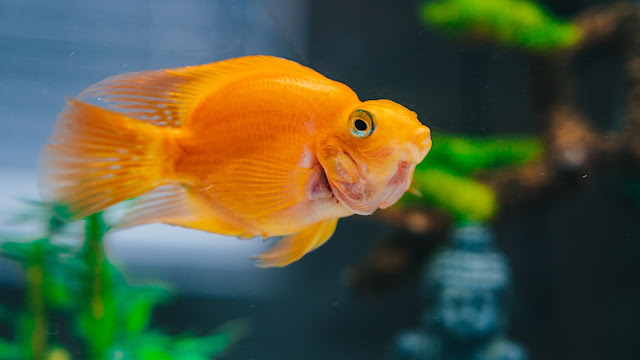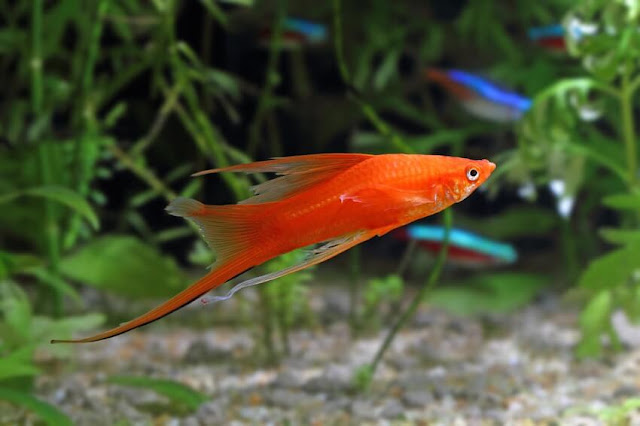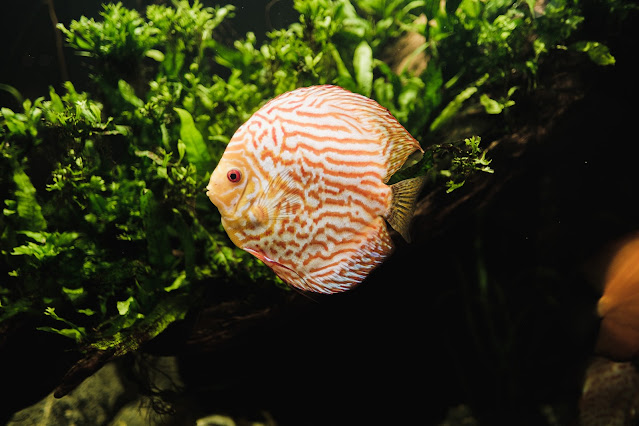If you're looking for a low-maintenance pet, consider adding a fish to your family. Pet fish come in a wide variety of species, each with their own unique characteristics and needs. From the hardy and easy-to-care-for goldfish to the brightly colored and active neon tetra, guppies and betta fish, there's a species that's perfect for every household. When researching pet fish species, it's important to consider factors like tank size, water temperature, pH levels, and diet to ensure that your fish thrive. Whether you're a first-time fish owner or a seasoned pro, a pet fish can provide hours of enjoyment.
Pet Fish
Pet fish are a popular choice among people looking for
low-maintenance pets. They come in a variety of species, each with their own
unique characteristics and needs.
Goldfish:
Goldfish are a species of freshwater fish that are popular
among fish enthusiasts. They are known for their bright colors, hardiness and
easy to care for, which makes them a great choice for first-time fish owners.
They come in a variety of colors, including orange, red, yellow, and even
black. They are native to East Asia and have been kept as pets for centuries.
Goldfish prefer water with a pH level of 6.0 to 8.0, a
temperature between 65 and 75 degrees Fahrenheit, and a water hardness between
5 and 20 dGH. They are hardy fish and can survive in a wide range of water
conditions, but they do require a well-maintained and spacious aquarium with
good filtration, a heater, and a moderate water flow.
Goldfish are also known to be social animals and they should
be kept in a group of at least six. They are also known to be peaceful fish,
but they can grow to be quite large, so they should be kept in a tank with a
capacity of at least 20 gallons per fish. They should be fed a diet of
high-quality flakes or pellets.
Goldfish come in many different varieties like the common
goldfish, comet goldfish, shubunkin goldfish, fantail goldfish and many more,
each with their own unique characteristics and color patterns. Some of them can
grow quite large and require a bigger tank, while others stay small and can be
kept in a smaller tank.
Goldfish are known for their beauty and hardiness, and they
can make a great addition to any aquarium. However, it's important to note that
they do produce a lot of waste and require a larger tank to accommodate for
their size as they grow. If you're interested in keeping Goldfish, it's
important to do your research and make sure that you have the proper setup and
knowledge to care for them.
Betta fish:
Betta fish, also known as Siamese Fighting Fish, are a
species of freshwater fish that are popular among fish enthusiasts. They are
known for their bright colors, long fins, and unique personalities. They are
native to Southeast Asia, specifically in Thailand, Malaysia, and Cambodia.
Bettas come in a wide variety of colors, including red, blue, green, purple,
and even black.
Betta fish prefer water with a pH level of 6.0 to 7.5, a
temperature between 76 and 82 degrees Fahrenheit, and a water hardness between
2 and 12 dGH. They are hardy fish and can survive in a wide range of water
conditions, but they do require a well-maintained and spacious aquarium with
good filtration, a heater, and a moderate water flow. Bettas can survive in
small bowls but they are recommended to be kept in a tank with a capacity of at
least 2 gallons.
It's important to note that Bettas are known for their
aggressive behavior and should be kept alone or with non-aggressive tankmates.
Bettas are also known to be territorial and can become aggressive if housed
with other Bettas. They should be fed a diet of high-quality flakes or pellets,
along with live or frozen foods such as brine shrimp, blood worms, and daphnia.
Bettas are known for their beauty, unique personalities, and
their ease of care. They are perfect for people who have limited space and
can't keep large aquariums. However, they are also known for being sensitive
and require a skilled aquarist to care for them properly. If you're interested
in keeping Betta fish, it's important to do your research and make sure that
you have the proper setup and knowledge to care for them.
Neon tetra:
Neon tetra fish are a species of freshwater fish that are
popular among fish enthusiasts. They are known for their bright neon colors,
small size and peaceful behavior. They are native to the rivers of South
America, specifically in the Orinoco and Amazon basins. Neon tetras come in a
variety of colors, including red, blue, green and even black.
Neon tetra fish prefer water with a pH level of 6.0 to 7.0,
a temperature between 72 and 82 degrees Fahrenheit, and a water hardness
between 2 and 12 dGH. They are hardy fish and can survive in a wide range of
water conditions, but they do require a well-maintained and spacious aquarium
with good filtration, a heater, and a moderate water flow. Neon tetras are
small fish and they should be kept in a tank with a capacity of at least 10
gallons per fish.
Neon tetras are also known to be social animals and they
should be kept in a group of at least six. They are also known to be peaceful
fish, and can be kept with other peaceful tankmates such as guppies, platies,
and rasboras. They should be fed a diet of high-quality flakes or pellets,
along with live or frozen foods such as brine shrimp, blood worms, and daphnia.
Neon tetras are known for their bright neon colors, small
size, and peaceful behavior. They are perfect for people who have limited space
and can't keep large aquariums. However, they are also known for being
sensitive and require a skilled aquarist to care for them properly. If you're
interested in keeping Neon tetra fish, it's important to do your research and
make sure that you have the proper setup and knowledge to care for them.
Guppies:
Guppies are a species of freshwater fish that are popular
among fish enthusiasts. They are known for their bright colors, small size, and
active behavior. They are native to the rivers of North and South America,
specifically in the Caribbean and Venezuela. Guppies come in a wide variety of
colors, including red, blue, green, yellow, and even black.
Guppies prefer water with a pH level of 6.5 to 8.0, a
temperature between 72 and 82 degrees Fahrenheit, and a water hardness between
2 and 12 dGH. They are hardy fish and can survive in a wide range of water
conditions, but they do require a well-maintained and spacious aquarium with
good filtration, a heater, and a moderate water flow. Guppies are small fish
and they should be kept in a tank with a capacity of at least 10 gallons per
fish.
Guppies are also known to be social animals and they should
be kept in a group of at least six. They are also known to be peaceful fish and
can be kept with other peaceful tankmates such as neon tetras, platies, and
rasboras. They should be fed a diet of high-quality flakes or pellets, along
with live or frozen foods such as brine shrimp, blood worms, and daphnia.
Guppies are known for their bright colors, small size, and
active behavior. They are perfect for people who have limited space and can't
keep large aquariums. However, they are also known for being sensitive and
require a skilled aquarist to care for them properly. If you're interested in
keeping Guppies, it's important to do your research and make sure that you have
the proper setup and knowledge to care for them.
Caring for pet fish is relatively easy, but it's important
to research the specific needs of the species you choose. Proper tank size,
water temperature, pH levels, and diet are all important factors to consider
when keeping fish as pets. With proper care, your pet fish can provide years of
enjoyment.
Top 10 Pet Fish:
Pet fish make great low-maintenance pets for people of all
ages. They come in a wide variety of species, each with their own unique
characteristics and needs. Here, we'll take a look at the top 10 pet fish
species that are perfect for any household.
Goldfish:
Goldfish are hardy and easy to care for, making them a great choice for
first-time fish owners. They come in a variety of colors, including orange, red,
and yellow, and can grow to be quite large. They prefer a tank with a filter
and a heater, and should be fed a diet of pellets or flakes.
Bettas:
Bettas,
also known as Siamese fighting fish, are known for their bright colors and long
fins. They should be kept in separate tanks as they can be aggressive towards
other fish. They prefer a tank with a heater and a filter, and should be fed a
diet of pellets or live food.
Neon Tetras:
Neon
tetras are small fish known for their bright neon colors and are easy to care
for. They prefer a tank with a heater and a filter, and should be fed a diet of
flakes or pellets. Neon tetras are also known to be very active fish, and they
should be kept in a group of at least six.
Guppies:
Guppies
are small, brightly colored fish that are easy to care for. They prefer a tank
with a heater and a filter, and should be fed a diet of flakes or pellets.
Guppies are also known to be very active fish, and they should be kept in a
group of at least six.
Angelfish:
Catfish:
Catfish
are hardy and easy to care for, making them a great choice for first-time fish
owners. They come in a variety of colors, and can grow to be quite large. They
prefer a tank with a filter and a heater, and should be fed a diet of pellets
or flakes.
Gourami:
Gourami
are a tropical fish that can be kept as pets. They are known for their
beautiful fins, and come in a variety of colors. They prefer a tank with a
heater, a filter and a good water flow. They are also known to be sensitive to
water quality and should be fed a diet of pellets, flakes or live food.
Cichlids:
Cichlids are a large family of fish that can be kept as pets. They come in a
variety of colors and are known for their bright fins. They prefer a tank with
a heater, a filter and a good water flow. They are also known to be sensitive
to water quality and should be fed a diet of pellets, flakes or live food.
Swordtail:
Swordtails are a tropical fish that can be kept as pets. They are known for their
beautiful fins, and come in a variety of colors. They prefer a tank with a
heater, a filter and a good water flow. They are also known to be sensitive to
water quality and should be fed a diet of pellets, flakes or live food.




















0 Comments